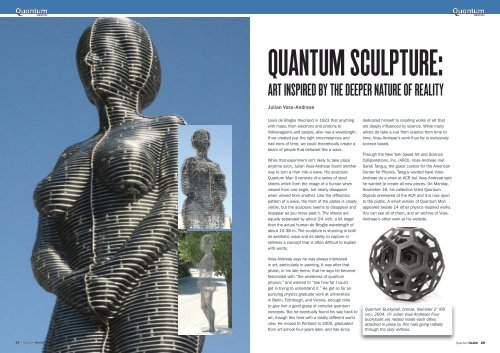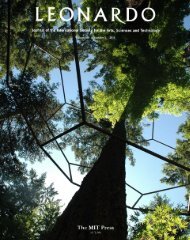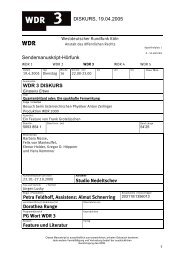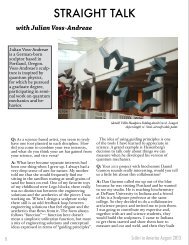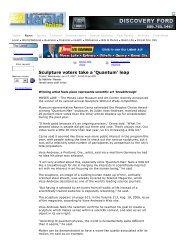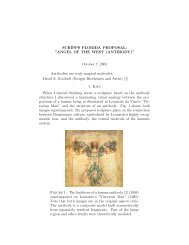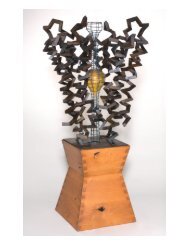art inspired by the deeper nature of reality - Julian Voss-Andreae
art inspired by the deeper nature of reality - Julian Voss-Andreae
art inspired by the deeper nature of reality - Julian Voss-Andreae
Create successful ePaper yourself
Turn your PDF publications into a flip-book with our unique Google optimized e-Paper software.
QUANTUM SCULPTURE:<br />
ART INSPIRED BY THE DEEPER NATURE OF REALITY<br />
<strong>Julian</strong> <strong>Voss</strong>-<strong>Andreae</strong><br />
Louis de Broglie <strong>the</strong>orized in 1923 that anything<br />
with mass, from electrons and protons to<br />
Volkswagsons and people, also has a wavelength.<br />
If we created just <strong>the</strong> right circumstances and<br />
had eons <strong>of</strong> time, we could <strong>the</strong>oretically create a<br />
beam <strong>of</strong> people that behaved like a wave.<br />
While that experiment isn’t likely to take place<br />
anytime soon, <strong>Julian</strong> <strong>Voss</strong>-<strong>Andreae</strong> found ano<strong>the</strong>r<br />
way to turn a man into a wave. His sculpture<br />
Quantum Man II consists <strong>of</strong> a series <strong>of</strong> steel<br />
sheets which form <strong>the</strong> image <strong>of</strong> a human when<br />
viewed from one angle, but nearly disappear<br />
when viewed from ano<strong>the</strong>r. Like <strong>the</strong> diffraction<br />
pattern <strong>of</strong> a wave, <strong>the</strong> front <strong>of</strong> <strong>the</strong> plates is clearly<br />
visible, but <strong>the</strong> sculpture seems to disappear and<br />
reappear as you move past it. The sheets are<br />
equally separated <strong>by</strong> about 3/4 inch, a bit larger<br />
than <strong>the</strong> actual human de Broglie wavelength <strong>of</strong><br />
about 10-38 m. The sculpture is stunning in both<br />
its aes<strong>the</strong>tic value and its ability to capture in<br />
stillness a concept that is <strong>of</strong>ten difficult to explain<br />
with words.<br />
<strong>Voss</strong>-<strong>Andreae</strong> says he was always interested<br />
in <strong>art</strong>, p<strong>art</strong>icularly in painting. It was after that<br />
phase, in his late teens, that he says he became<br />
fascinated with “<strong>the</strong> weirdness <strong>of</strong> quantum<br />
physics,” and wanted to “see how far I could<br />
get in trying to understand it.” He got so far as<br />
pursuing physics graduate work at universities<br />
in Berlin, Edinburgh, and Vienna, enough time<br />
to give him a good grasp <strong>of</strong> complex quantum<br />
concepts. But he eventually found his way back to<br />
<strong>art</strong>, though this time with a totally different world<br />
view. He moved to Portland in 2000, graduated<br />
from <strong>art</strong> school four years later, and has since<br />
dedicated himself to creating works <strong>of</strong> <strong>art</strong> that<br />
are deeply influenced <strong>by</strong> science. While many<br />
<strong>art</strong>ists do take a cue from science from time to<br />
time, <strong>Voss</strong>-<strong>Andreae</strong>’s work thus far is exclusively<br />
science based.<br />
Through <strong>the</strong> New York based Art and Science<br />
Collaborations, Inc. (ASCI), <strong>Voss</strong>-<strong>Andreae</strong> met<br />
Sarah Tanguy, <strong>the</strong> guest curator for <strong>the</strong> American<br />
Center for Physics. Tanguy wanted have <strong>Voss</strong>-<br />
<strong>Andreae</strong> do a show at ACP, but <strong>Voss</strong>-<strong>Andreae</strong> said<br />
he wanted to create all new pieces. On Monday,<br />
November 16, his collection titled Quantum<br />
Objects premiered at <strong>the</strong> ACP, and it is now open<br />
to <strong>the</strong> public. A small version <strong>of</strong> Quantum Man<br />
appeared beside 14 o<strong>the</strong>r physics-<strong>inspired</strong> works.<br />
You can see all <strong>of</strong> <strong>the</strong>m, and an archive <strong>of</strong> <strong>Voss</strong>-<br />
<strong>Andreae</strong>’s o<strong>the</strong>r work at his website.<br />
Quantum Buckyball, bronze, diameter 2’ (60<br />
cm), 2004. (© <strong>Julian</strong> <strong>Voss</strong>-<strong>Andreae</strong>) Four<br />
buckyballs are nested inside each o<strong>the</strong>r,<br />
attached in place <strong>by</strong> thin rods going radially<br />
through <strong>the</strong> sixty vertices.<br />
24 Quantum Health Quantum Health 25
“The term ‘Quantum Object”’ although regularly<br />
used in physics, is really an oxymoron,” writes<br />
<strong>Voss</strong>-<strong>Andreae</strong> in his description <strong>of</strong> <strong>the</strong> collection.<br />
“An ‘object’ is something that lives completely in<br />
<strong>the</strong> paradigm <strong>of</strong> classical physics.”<br />
It’s a subtlety that only a physicist could point out,<br />
and only an <strong>art</strong>ist could take advantage <strong>of</strong>. Things<br />
that exist in <strong>the</strong> quantum world do not exist<br />
as classical objects–it is p<strong>art</strong>ly this distinction<br />
that makes <strong>the</strong>m quantum. For example, an<br />
electron orbiting <strong>the</strong> nucleus <strong>of</strong> an atom does<br />
not take one distinct path, but all possible paths,<br />
until we measure it. But we still try to create<br />
representations <strong>of</strong> an electron circling around a<br />
nucleus–first as a little round ball taking a very<br />
clear cut path, and <strong>the</strong>n later adapting that image<br />
to look more like a cloud surrounding <strong>the</strong> nucleus.<br />
There are many classical representations <strong>of</strong> <strong>the</strong><br />
quantum world used <strong>by</strong> physicists like <strong>the</strong> path<br />
<strong>of</strong> an electron, or just <strong>the</strong> idea <strong>of</strong> point p<strong>art</strong>icles<br />
as little round balls. Even so, <strong>the</strong>se images are<br />
inconsistent throughout physics literature because<br />
people are constantly trying to alter <strong>the</strong>m slightly<br />
so that <strong>the</strong>y will better capture <strong>the</strong> quantum<br />
essence.<br />
Faced with <strong>the</strong> challenge <strong>of</strong> turning quantum<br />
objects into classical ones, <strong>Voss</strong>-<strong>Andreae</strong> is<br />
presented with two opportunities. One is to<br />
simply make standard classical representations <strong>of</strong><br />
quantum objects more aes<strong>the</strong>tically pleasing. He<br />
certainly does this, and does it exceptionally well,<br />
but this is something that a dedicated text book<br />
could also tackle. The second opportunity he is<br />
presented with, one that requires a background in<br />
physics, is to infuse <strong>the</strong> classical representations<br />
Quantum Reality (Large Buckyball around Trees)<br />
(view from below), steel and trees, diameter <strong>of</strong><br />
<strong>the</strong> steel structure 30’ (9 m), 2007. (© <strong>Julian</strong><br />
<strong>Voss</strong>-<strong>Andreae</strong>) A 30’ (9 m) diameter buckyball is<br />
suspended in <strong>the</strong> air <strong>by</strong> large Douglas firs. The<br />
photo was taken from under <strong>the</strong> buckyball.<br />
<strong>of</strong> quantum objects with some philosophical<br />
interpretation. While <strong>the</strong> pieces <strong>of</strong> Spin Family use<br />
<strong>the</strong> p<strong>art</strong>icles-as-little-balls idea, he also takes <strong>the</strong><br />
notion <strong>of</strong> a “family” <strong>of</strong> p<strong>art</strong>icle fur<strong>the</strong>r, equating<br />
a p<strong>art</strong>icle’s spin with gender. His piece “Night<br />
Path,” interprets Richard Feynman’s technique<br />
to measure all possible paths that a p<strong>art</strong>icle<br />
could take <strong>by</strong> “slicing up” segments <strong>of</strong> spacetime<br />
and creating all possible paths. The result<br />
is a stunning work <strong>of</strong> <strong>art</strong> in which a divided up<br />
black box holds taut gold threat that collectively<br />
trace a curved path. <strong>Voss</strong>-<strong>Andreae</strong> says <strong>the</strong> path<br />
“connects <strong>the</strong> idea <strong>of</strong> <strong>the</strong> quantum mechanical<br />
path to <strong>the</strong> image <strong>of</strong> a meteor, a rock falling<br />
through <strong>the</strong> dark <strong>of</strong> <strong>the</strong> night, <strong>of</strong>ten believed to be<br />
connected to a meaningful event.”<br />
The additional challenge for <strong>Voss</strong>-<strong>Andreae</strong> is<br />
creating classical interpretations <strong>of</strong> quantum<br />
objects where <strong>the</strong>re are few or none previously<br />
established. What object represents symmetry<br />
breaking? This phenomenon begins with a<br />
system suddenly being presented with multiple<br />
possible paths, or multiple energy minima. So<br />
<strong>Voss</strong>-<strong>Andreae</strong> uses hanging chains to represent<br />
a graph <strong>of</strong> those energy minimums. Some look<br />
<strong>the</strong> way we expect–a chain hanging down in a<br />
‘U’ shape–while o<strong>the</strong>r possible paths look more<br />
and more as if <strong>the</strong>y are defying gravity. When <strong>the</strong><br />
system choses a path, symmetry is broken, and it<br />
may produce an equally counter-intuitive result.<br />
Concepts like symmetry breaking and <strong>the</strong> de<br />
Broglie wavelength aren’t p<strong>art</strong> <strong>of</strong> non-science<br />
vernacular, but <strong>Voss</strong>-<strong>Andreae</strong> says he wants <strong>the</strong><br />
general public to enjoy <strong>the</strong> works. He wrote in an<br />
Quantum Man 2, stainless steel, height 100” (2.50 m), 2007. (© <strong>Julian</strong> <strong>Voss</strong>-<strong>Andreae</strong>) The image shows<br />
three views <strong>of</strong> <strong>the</strong> same sculpture.<br />
email message, “What I want<br />
is to increase <strong>the</strong> audience’s<br />
capacity to intuit <strong>the</strong> <strong>deeper</strong><br />
<strong>nature</strong> <strong>of</strong> <strong>reality</strong> <strong>by</strong> sensually<br />
experiencing <strong>the</strong> works.”<br />
However, <strong>Voss</strong>-<strong>Andreae</strong> says<br />
when he began <strong>the</strong> project he<br />
had physicists in mind, and<br />
wanted to create something<br />
“that <strong>the</strong>y could relate to.” It<br />
is perhaps more common for<br />
<strong>art</strong>ists tackling science to have<br />
<strong>the</strong> goal <strong>of</strong> making <strong>the</strong> science<br />
more digestible for <strong>the</strong> general<br />
public; not many <strong>art</strong> projects<br />
are <strong>of</strong>fered up mainly for <strong>the</strong><br />
enjoyment <strong>of</strong> physicists. Could such a project not<br />
only entertain <strong>the</strong>m, but give <strong>the</strong>m something<br />
new to think about?<br />
<strong>Voss</strong>-<strong>Andreae</strong> says that one key benefit <strong>of</strong> making<br />
<strong>art</strong> about science is that it requires taking a<br />
step back to look at <strong>the</strong> larger picture. <strong>Voss</strong>-<br />
<strong>Andreae</strong>’s own career change and subsequent<br />
change in perspective made him look differently<br />
on science’s attempt to always break down<br />
<strong>the</strong> natural world into smaller pieces, and draw<br />
conclusions without looking at <strong>the</strong> larger picture.<br />
He uses nutrition as an example.<br />
“We know quite a bit about single molecules such<br />
as vitamins and how <strong>the</strong>ir lack affects our health,”<br />
he said. “Extrapolating from that though, we<br />
tend to believe that a diet consisting <strong>of</strong> burgers<br />
and fries is OK as long as we have our vitamin<br />
Figure 11: The Universe (The Cellular<br />
Structure <strong>of</strong> Space-Time), bronze,<br />
diameter 8” (20 cm), 2009. (© <strong>Julian</strong><br />
<strong>Voss</strong>-<strong>Andreae</strong>) The simplicity <strong>of</strong> <strong>the</strong><br />
dark exterior stands in stark contrast<br />
to <strong>the</strong> complex golden interior shaped<br />
<strong>by</strong> <strong>the</strong> forces <strong>of</strong> physics.<br />
pills with it. But…nutrition<br />
is a concert <strong>of</strong> thousands <strong>of</strong><br />
molecules toge<strong>the</strong>r.”<br />
In relation to physics, he<br />
says his work has drawn him<br />
back to <strong>the</strong> philosophical<br />
implications <strong>of</strong> quantum<br />
mechanics, discussed <strong>by</strong><br />
physicists like Bohr and<br />
Einstein, and many <strong>of</strong> which<br />
are still open ended.<br />
“It is easy as a physicist to<br />
essentially…[believe] that we<br />
don’t really have a problem<br />
with quantum mechanics<br />
because it is such a fabulous tool to predict <strong>the</strong><br />
outcome <strong>of</strong> all experiments we have designed,”<br />
said <strong>Voss</strong>-<strong>Andreae</strong>. “It is wise to step back every<br />
now and <strong>the</strong>n, re-connect <strong>the</strong> dots and keep <strong>the</strong><br />
bigger picture in mind.”<br />
<strong>Voss</strong>-<strong>Andreae</strong>’s work has leaned more and more<br />
toward biology in recent years, and he says he<br />
feels himself pulled in that direction. While <strong>the</strong><br />
study <strong>of</strong> <strong>the</strong> human body is a whole new realm<br />
for him, he is fascinated in p<strong>art</strong>icular with <strong>the</strong><br />
structure <strong>of</strong> proteins, which led him to create his<br />
largest piece called Angel <strong>of</strong> <strong>the</strong> West, depicting<br />
<strong>the</strong> molecular structure <strong>of</strong> <strong>the</strong> human antibody.<br />
1517 SE Holly Street Portland, OR, 97214, USA<br />
E-mail: info@julianvossandreae.com<br />
Website: www.<strong>Julian</strong><strong>Voss</strong><strong>Andreae</strong>.com<br />
26 Quantum Health Quantum Health 27


